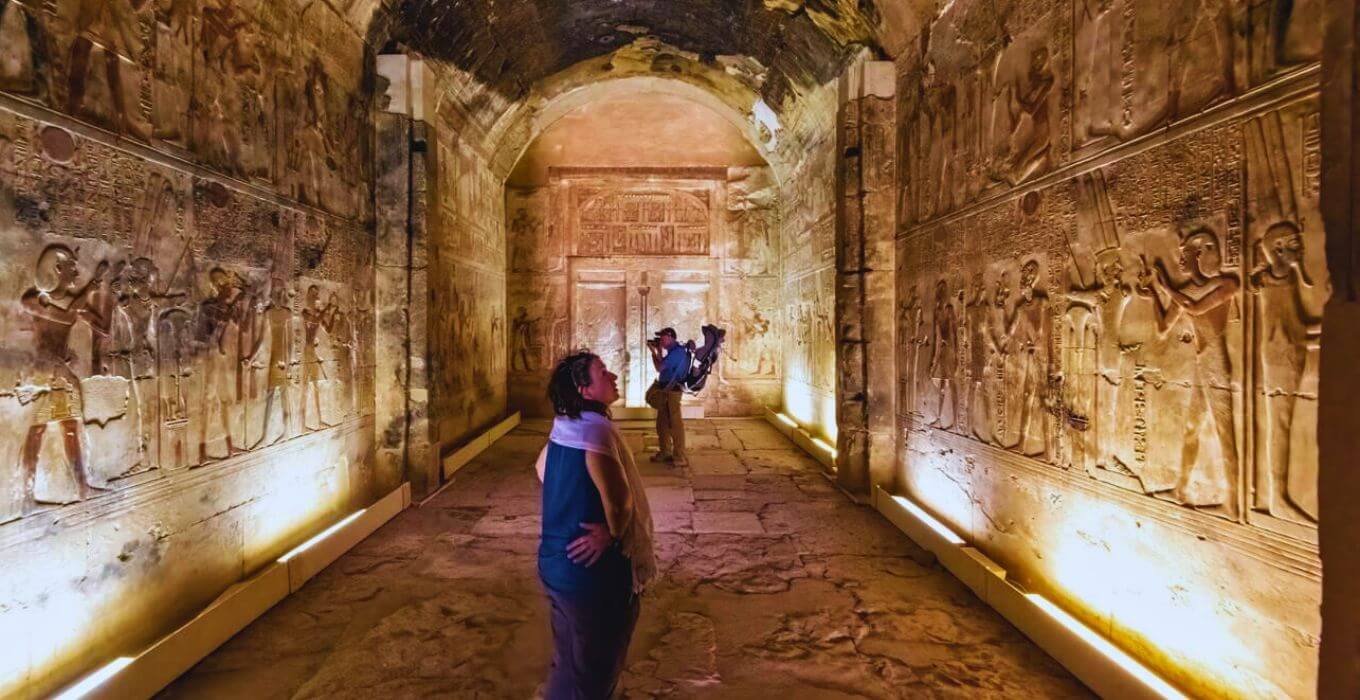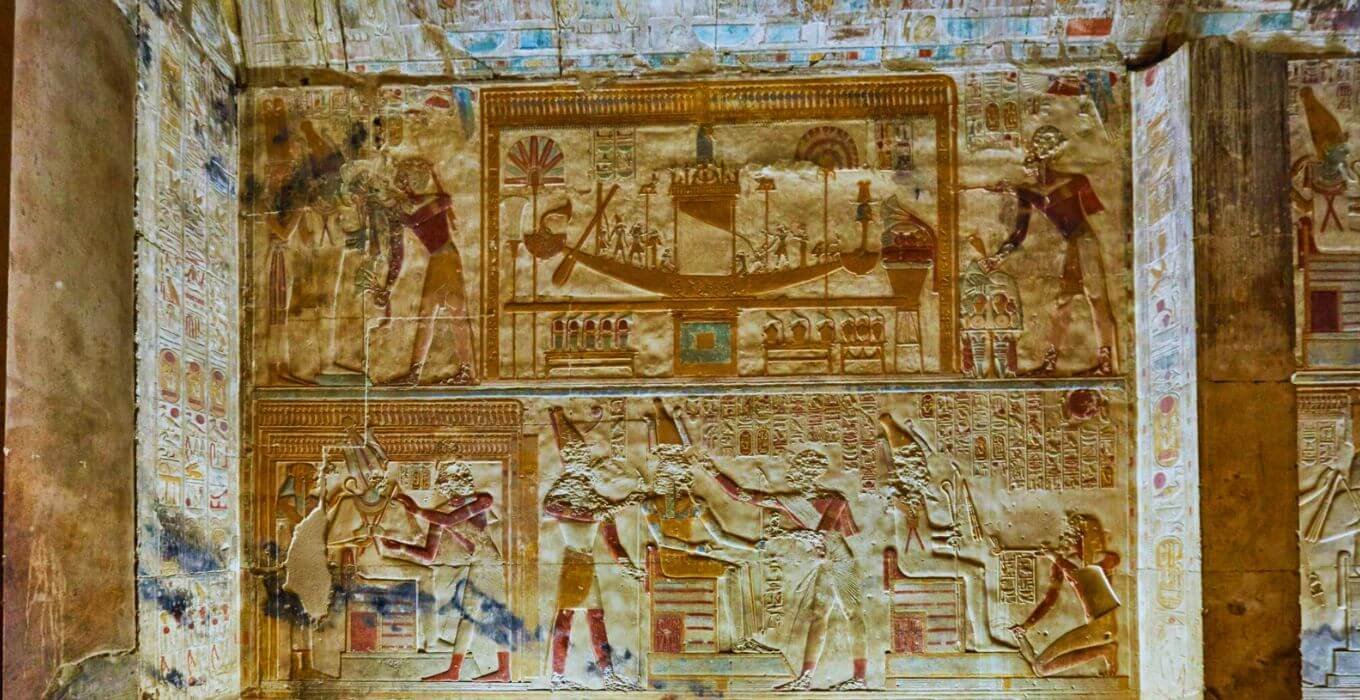What secrets hide in the Temple of Abydos, a sacred site in ancient Egypt? This temple, in the low desert west of the Nile, has seen the rise and fall of pharaohs. It has also seen changes in religious practices and the lasting legacy of a civilization that has amazed the world for thousands of years. Let’s uncover the mysteries of this ancient temple and learn about its deep cultural and historical importance.
Key Takeaways
- The Temple of Abydos is a famous ancient Egyptian architectural wonder in Upper Egypt, about 2.5 hours north of Luxor.
- It’s built mainly of limestone and has a pylon, two open courts, two hypostyle halls, and seven small antechambers for different Egyptian gods.
- The temple is famous for its well-preserved temple reliefs, many of which still show their original colors.
- Abydos was a key religious site for the ancient Egyptians. They made pilgrimages there to honor the god Osiris and to be buried near his tomb.
- The Temple of Seti I, the biggest and most important temple at Abydos, is a masterpiece of Pharaonic architecture. It shows the artistic and engineering skills of ancient Egyptian civilization.
The Sacred City of Abydos
Abydos was a key ancient Egyptian necropolis and a sacred city. It’s located about 11 kilometers (6.8 miles) west of the Nile River. The site’s history spans from the First Dynasty to the Thirtieth Dynasty.
Abydos: A Prominent Sacred City of Ancient Egypt
The Umm al-Qaʿāb area in Abydos is famous as the royal cemetery of the 1st and 2nd dynasties. Excavations here have uncovered tombs of Predynastic Egyptian kings. These discoveries include intact pottery, royal symbols, and ivory labels.
Location and Historical Significance
Abydos was not just a necropolis but also a center for the worship of the god Osiris. The cult of Osiris, the god of the earth, was established here during the Fifth Dynasty. Abydos was a cultural hub where the mysteries of Osiris were celebrated.
The Temple of Seti I at Abydos
Architectural Grandeur and Intricate Reliefs
The Temple of Seti I is a key site in Abydos, known for its grand Pharaonic architecture. It’s built mainly from limestone and is huge, measuring 183 feet by 515 feet. It has a pylon, two open courts, two hypostyle halls, and seven small rooms for different gods.
The temple’s walls are covered in delicate reliefs made by skilled ancient Egyptian artists. Many of the original colors are still bright, showing the Pharaonic era’s vibrant art.
Honoring the Gods and Pharaohs
The Temple of Seti I was more than a place of worship. It was also a key part of the cult of Osiris, the god of the underworld. Seti I and his son, Ramesses II, honored the gods and their ancestors with detailed reliefs and offerings.
A standout feature is the long gallery with a relief of Seti I and Ramesses II. They made offerings to the cartouches of 76 of their ancestors. This list, known as the Abydos Kings List, is a treasure trove of ancient Egyptian history.
The Osireion: Seti I’s Symbolic Tomb
Behind the grand Temple of Seti I at Abydos lies the Osireion. It’s a special monument thought to be a cenotaph for Seti I. Found by Flinders Petrie and Margaret Murray in 1902-03, it’s an underground hall with a central platform and ten huge granite pillars. It’s surrounded by a water channel.
The Osireion isn’t directly linked to Osiris, but it honors Seti I. Its design, like Valley of the Kings tombs, shows a symbolic connection to Seti I’s burial. The presence of Flower of Life symbols shows the ancient Egyptians’ interest in sacred geometry.
Building the Osireion was a big challenge. The massive granite pillars, up to 100 tons each, came from Aswan. Despite its unique style, many think it was built by Seti I’s son, Merenptah.
|
Feature |
Description |
|
Vaulted Hall |
The Osireion is an underground vaulted structure, mirroring the rock-cut tombs in the Valley of the Kings. |
|
Central Platform |
At the center of the Osireion stands a platform with ten massive granite pillars, some weighing up to 100 tons. |
|
Surrounding Moat |
The central platform is surrounded by a channel of water, creating a symbolic ‘moat’ around the structure. |
|
Seti I Cenotaph |
The Osireion is believed to have been constructed as a cenotaph, or symbolic tomb, to honor the pharaoh Seti I. |
The Osireion’s true purpose and when it was built are still debated. Yet, it fascinates everyone who sees it. It gives us a peek into ancient Egypt’s architecture and beliefs.

The Temple of Ramesses II at Abydos
Continuing the Legacy of Pharaonic Architecture
Close to the Temple of Seti I, the Temple of Ramesses II stands. It’s not as big, but its painted relief carvings are stunning. These carvings show the beauty of Pharaonic architecture at Abydos.
The Temple of Ramesses II was built in the 19th Dynasty, around 1279-1213 BCE. It’s near Cairo, about 300 miles south, and 7 miles west of the Nile. Auguste Mariette started digging here in 1869, figuring out when it was built.
The temple’s design is typical, with a Pylon, a Court, a Portico, and more. Though some parts are missing, the lower levels have amazing bas-reliefs. These reliefs still show their bright colors, giving us a peek into ancient Egyptian art.
Today, archaeologists keep digging at Abydos. They help us learn more about this ancient wonder. This work keeps the memory of Ramesses II and Pharaonic traditions alive.
Abydos: A Pilgrimage Center for Ancient Egyptians
Abydos was a key city in ancient Egypt. It was where many Egyptians wanted to be buried near Osiris, the god of the dead. This made Abydos a major pilgrimage site for those who revered the Nile.
The Importance of Burial at Abydos
Those who couldn’t afford burial at Abydos created stelae instead. These stone tablets had the person’s name, titles, and a prayer to Osiris. Thousands of these have been found, showing the deep respect for ancient Egyptians had for burial at Abydos.
Abydos, near Al-Balyanā, is a treasure trove of history. It has tombs from before the 1st dynasty of Egypt. These tombs have given us pottery, royal symbols, and ivory labels, offering insights into ancient Egypt.
Over time, the Osiris temple at Abydos was expanded by many pharaohs. Pepi I, Thutmose III, Ramses III, and Ahmose II all contributed. This made Abydos a sacred place for pious Egyptians. Even pharaohs from later times built temples there, showing its lasting importance.
The Temple of Abydos
The Abydos archaeological site is a vast, unexplored treasure. It covers about 5 square miles. Archaeologists have just started to uncover its secrets. The Temple of Seti I is the largest structure they’ve found so far.
The Temple of Seti I was built after Seti I’s death by his son, Ramesses II. It’s considered one of the most important sites in Abydos. Its design and materials make it a true architectural wonder.
Visitors are amazed by the temple’s size and detailed reliefs. The entrance leads to a court, then a portico with twelve columns. The Osiris Hall was the heart of temple rituals. The Corridor of the Lists houses the famous “Abydos King List.”
Underneath the main temple is the Osirion. It was found by Flinders Petrie and Margaret Murray in the early 1900s. This symbolic tomb for Osiris adds to the temple’s deep religious meaning.
Even with the progress on the Temple of Seti I, most of Abydos is still hidden. The ongoing archaeological exploration at Abydos is set to reveal more about ancient Egypt’s history and culture.
|
Key Facts about the Abydos Temple Complex |
|
Visiting the Temple of Abydos
Getting There and Planning Your Visit
Visiting the ancient Temple of Abydos in Egypt is a rewarding experience. It’s located in El Araba El Madfuna, Middle Egypt. This is about 50 km north of Sohag and 190 km south of Luxor.
There are several ways to get to Abydos. Many tour companies offer day trips from Luxor. Some Nile cruises also stop at Abydos, making it part of a bigger journey.
Visitors might need a police escort due to security. It’s important to check the arrangements in advance. This ensures a safe and smooth visit.
Winter, from November to February, is the best time to visit. The temple is open from 8 am to 5 pm (7 am to 6 pm in summer). The entrance fee is 100 Egyptian pounds.
Plan to spend about 2 hours at the temple. This will give you time to see its grand architecture and detailed reliefs. These honor the gods and pharaohs of ancient Egypt.
|
Transportation Options |
Visiting Information |
|
|
The Abydos Kings List: A Remarkable Historical Record
The Temple of Seti I in Abydos, Egypt, is famous for the Abydos Kings List. It lists all 76 pharaohs before Seti I. This document is from the New Kingdom, Dynasty 19, around 1290-1279 BCE.
The Abydos Kings List was made by Seti I to prove his right to the throne. He carved the names of his predecessors on the temple walls. This list is key for Egyptologists today, showing the early dynasties of ancient Egypt.
The list has 38 kings in each of the first and second registers, in vertical cartouches. The Abydos Kings List is unique because it leaves out some rulers and adds 17 names not found elsewhere. It covers the First Intermediate Period, the reign of female king Sobekneferu, the Second Intermediate Period, and the Amarna Period.
The Abydos Kings List is similar to other records like the Karnak Kings List and the Palermo Stone. It gives a detailed chronological list of Pharaonic history. This document is still crucial for scholars studying ancient Egyptian civilization.
Conclusion
The Temple of Abydos is a symbol of ancient Egyptian culture and religion. It was a sacred city and a key archaeological site in Egypt. The ancient Egyptians went there to honor the god Osiris and to be buried near his tomb.
The Temple of Seti I shows off the grand architecture and detailed reliefs of ancient Egypt. It also has the Abydos Kings List, which tells us about the Pharaonic history. The Osireion, with its tall columns, highlights the site’s spiritual value and the Egyptians’ belief in the afterlife.
Visiting the Temple of Abydos lets travelers see the ancient wonders of Egypt. It helps them understand the country’s rich cultural heritage. From the pre-dynastic period to the New Kingdom, the site was important for religion, politics, and culture. It’s a must-see for anyone interested in ancient Egypt’s history.
Read other related articles:


